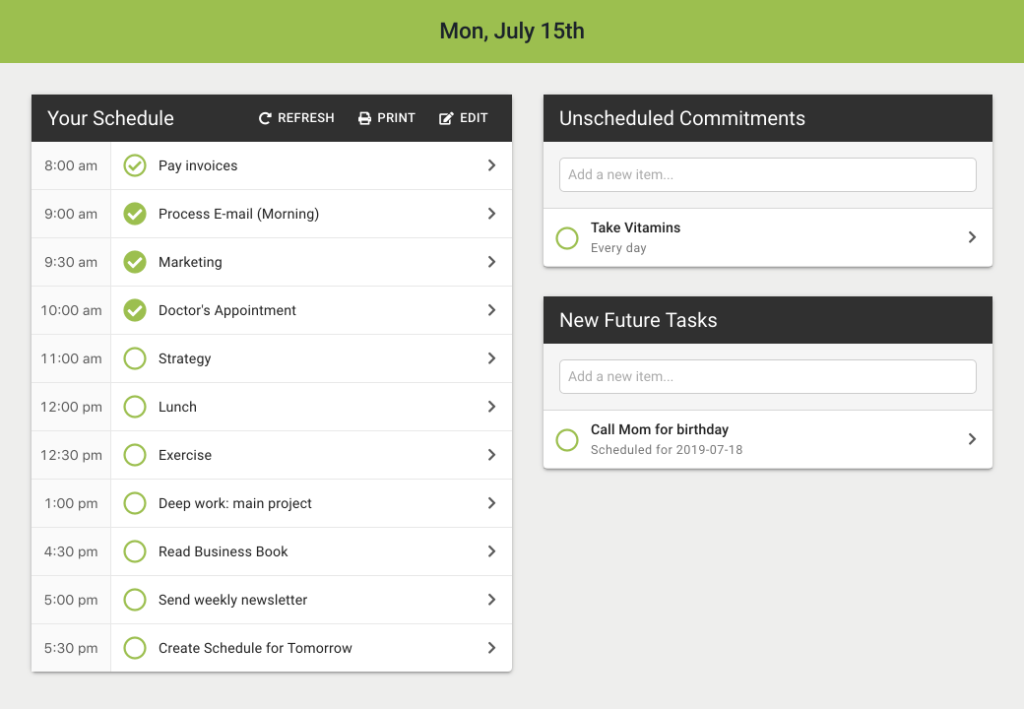What is the best way to manage your time? Well…it depends.
Rather than give you specific advice, which requires knowing your specific situation, I’m going to give you a few principles you can use to decide for yourself the best way to manage your time.
Let’s get started…
1. Think Holistically
Anything you spend time on takes time away from something else that you could be spending your time on. Avoid thinking about managing your time in isolation. Don’t focus on how to manage time for a specific project; focus on how that project fits into all of your available time.
Two ways to think about this…
From a long-term perspective, build a Life Portfolio that captures everything that you’ve spent your time on over the past few months. Then figure out how much time you spend each week on each aspect. Remember: you only have 168 hours each week, so ensure that your time equals 168 hours.

By capturing all of your time use in a single place, you’ll be better positioned to make deliberate trade-off decisions on where to spend your time. It also can help you phase out low-value activities that no longer serve you.
From a short-term perspective, consider not only your tasks, but also your appointments and daily activities.
The difference between task management and time management is that task management focuses on what you need to get done, while time management focuses on when and for how long.
Everything you need or want “to do” falls into one of 3 buckets:
- Tasks
Things that you need to work on that will eventually be done (usually managed on your task list) - Appointments:
Events that you need to attend (usually managed on your calendar) - Activities
Everything else that takes up time in your day: meals, exercise, breaks, etc. (often forgotten)
To think holistically, you need to consider ALL of your to-dos, not just the tasks on your task list.
2. Discover Your Context
Productivity is personal. What works for one person doesn’t necessarily work for someone else. Nor will the same strategies work for you throughout your entire life. The strategies that work best for you at any given moment are dependent on:
- Personality
Some people experience anxiety if they build a schedule and can’t follow it exactly; other’s don’t. Some people need a deadline to get motivated; other’s don’t. Some people like rigid routines; other’s don’t. - Role
Managers, makers and entrepreneurs, among others, all have different time management needs. Managers spend a large part of their time in meetings, while makers require uninterrupted time to get into the flow. Entrepreneurs need to balance multiple competing priorities, while others may simply be responding to incoming support tickets or working down a single task backlog. - Workload
How many tasks and projects are active for you? Do you even have defined tasks, or do you need to explore to discover these? How tight are your deadlines? What are the consequences of missing your deadlines? - Environment
How often are you interrupted or distracted? What aspects of your environment can you control or not? How optimized is your environment to the type of work you are doing?
This isn’t meant to be a comprehensive list. There may be other aspects that represent your personal context, or you may define the above aspects differently. What is key is that context matters, and knowing your own personal context can help you make better decisions on how to manage your time.
When you hear a piece of productivity advice, always ask in which context this advice is most effective. No advice works 100% of the time. Find the strategies that work best for your context, and learn how to ask others about their context so you can pattern match what other strategies might work for you.
3. Choose What to Manage
It’s become popular with productivity advice to say that you can’t manage your time, but you can manage X—where X represents tasks, attention, energy, etc.
That’s not entirely true, nor entirely false. Tasks, time, attention, energy and many other things work together in a system, affecting each other.
The reality is that you can manage your time directly, or you can manage it indirectly by managing your tasks, attention or energy.
For instance, when you manage your attention, your will alter how you use your time, what energy you have and what tasks you can accomplish. These are not independent aspects of your productivity.
When you are first getting started, however, it’s nearly impossible to manage all these things at once. So pick only one thing to manage.
Which one? It depends on your context. Different people will find that different aspects work. And when your context changes, so might the strategy that works most effectively for you. So experiment.
Once you have experience managing one of these aspects, you can start to add other aspects in as secondary aspects to manage.
For instance, say you are directly managing your time by creating a daily schedule. You can then start scheduling your to-dos based on your circadian rhythm so the types of each to-do matches your energy at that time. But don’t start off doing managing multiple aspects, work your way up to it.
4. Leverage Constraints
People often think of constraints as a bad thing. Yet constraints are a critical part of creativity. They are also a critical part of managing your time effectively. Time is not an unlimited resource, thus, the constraints you decide to take on determine how effectively you use your time.
A few ideas of how constraints can help:
- Time: Use Time Blocking
Define a specific amount of time you will work on a task and limit yourself to that. Even if you don’t finish and need to extend, the process of blocking out your time helps shift your brain into a more focused state, helping you work more effectively. - Attention: Install Access Blockers
Install software to block which web sites and apps you can access. Use this techology to avoid wasting energy resisting the temptation to visit distracting places (or falling to that temptation and getting distracted). - Tasks: Limit the Scope
Define a clear scope for what a task will entail and what it won’t entail, before you start. Avoid taking on ill-defined tasks inadvertently, and when you do need to do these, carve out smaller scoped tasks so you can more clearly see the unscoped parts. - Energy: Align to Your Rhythms
Decide which tasks to do based on your fluctuating energy through the day, week and month. Match tasks to your circadian and other rhythms, and avoid doing tasks which require high energy when your energy is low (and vice versus).
Think of constraints as being a coach or companion in your time management. They help you avoid falling into bad patterns and nudge you toward effective use of your time.
5. Plan Regularly
Priorities and contexts change. Often, however, we don’t realize it until we start experiencing some disconnect. A regular planning process can help us course correct before we drift too far.
Regular planning also helps us uncover potential obstacles, make trade-off decisions, track our progress and improve over time.
How you plan is actually less important than how often you plan. A perfect planning process done once a year cannot beat an imperfect planning process done once a week.
Ideally you plan at multiple cadences:
- Short-Term: Daily or Weekly
- Medium-Term: Monthly or Quarterly
- Long-Term: Yearly or Longer
By planning at multiple cadences, you can envision long-term goals, but then take the steps to adjust your plan in the medium and short term to reach those goals. Each time you plan, review what you did during the last period, then make adjustments based on your review for the next period.
Keep in mind that you don’t need to use the same planning process at each cadence. For instance, you may use the CASE method to plan your day, but a +/-/delta method to do medium- and long-term planning.
6. Audit & Analyze Occasionally
Without insight into your actual time use, it’s hard to know if you’re effectively managing your time. Thus, to anchor your strategies in a ground truth, it’s useful to audit and analyze your time use from time to time.
Audit your time by keeping a time log or using a 24/7 time-tracking app like Eternity for a week or two, then look back at your time usage to see how you are actually using your time versus how you think you’re using it.
The key to doing an effective audit is to record whenever you switch tasks—whether deliberately or because of an interruption or distraction. By simply recording your switch times and what you are switching to, you can create a holistic view of all of your time use over a week or two.
Once you have your time log, you can analyze it in several ways:
- Aggregate time use by categories to see where you are spending your time
- Look for rapid shifts that indicate patterns of interruptions or distractions
- Identify time spent doing low-value activities
With this information, you can brainstorm strategies to improve your time use going forward. And if you use the same activities from your life portfolio in your time audit, you can see how your ideal time use matches your actual time use.
7. Connect Priorities to Actions
It goes without saying that you should prioritize your tasks, appointments and activities. Prioritization strategies are numerous and I won’t go over them here. Instead, let’s talk about what you do with those to-dos after you’ve prioritized them.
Priorities should be connected to actions. What I mean by that is that, once you have set your priorities, you should know when and how you’ll approach that priority. Pre-decide how to handle each, either now or in the future.
Take your priorities and connect them to actions like:
- Eliminate
Make a decision to never do these things and remove them entirely from consideration. - Dream
Decide you may do these someday, and may fantasize about them from time to time, but have no specific timeline. - Defer
Write down a specific a future date or trigger for when these will become relevant to pay attention to again. - Bumpers
Mark these as optional things that can be bumped if needed. These are “nice to dos”, not “must dos”. - Foundational
Commit to doing these regardless of other priorities, because they are critical to your success or well being. These are non-negotiable. - Anchors
Decide which things will have the most impact and organize your time around these key items; only foundational priorities trump these.
You may define other actions as well. The key is to decide in advance how you’ll treat a priority so you’re not making a decision in the moment, when you’re stressed, pressed for time and not thinking as clearly.
8. Learn Your Jumpstarts
Figure out what gets your juices flowing for specific types of tasks. A jumpstart is a technique that shifts your mood into a specific state to help you get started.
Jumpstarts depend on what state you want to shift into. Different types of tasks may require different jumpstarts.
Some jumpstarts to experiment with include:
- Edit to Create
To get into the mode to create, try editing first. Editing shifts you into an active role with your creative medium, which prepares you to tackle a blank slate. If writing, edit one of your old articles—or even someone else’s. If coding, refactor your code. If painting, touch up a prior piece. - Create to Flow
When you have nothing to edit, start the creation process with a purposeful throwaway. The aim is merely to get your creative juices flowing. Write about what you see in front of you, improvise a song about your troubles writing a song, write a sarcastic opening to your report or proposal. Add constraints to aid the creation process: pick an unusual theme, decide that you cannot pause during the process, do it standing up, etc. - Play to Warmup
Play a game that requires you to use the same physical or mental muscles you need for your main task. Identify games you can play quickly that you can quickly disengage from, so you use them as a jumpstart, not a distraction. - Frivolous to Important
Start with a small, low-priority task that’s easy to do. Accomplishing the task will give you momentum to tackle your more important tasks. To lift your mood at the same time, choose an indulgent task—one that you really want to see done, but have been ignoring because it’s low priority. - Dress the Part
Change your clothes or appearance to shift your mindset. Ideally do this 10–15 minutes before your anticipated start. Put on your running clothes to nudge yourself to run. Dress up in a suit before doing sales calls. Associate tokens like hats, silly socks or other articles of clothing with specific states to get brought quickly back to those states when you put them on. - Shift Your Environment
Switch to a different room or switch something up in your environment to cue your brain that you will be doing different work. This is the environment equivalent of Dress the Part.
Pay attention as you go throughout your day to what small activities give you energy or shift you into a new mindset. Write these down and give them names so you can easily reference them. Then next time you’re having a hard time getting started, try out one of your jumpstarts to help you shift into the task you’re having trouble with.
The key to successfully using jumpstarts is to avoid getting lost in them. Set yourself a time limit, and monitor how long it takes for you to move from your jumpstart to your main activity. You may discover certain activities act as procrastination devices, not jumpstarts. Avoid those in the future.
9. Improve & Adapt
When things don’t go according to plan, adapt. Remain flexible and change your plan. Don’t rigidly stick to a plan that isn’t working or no longer reflects reality.
Planning is important because it helps you think through potential opportunities and obstacles in the future. Your plan is just an artifact of that process that helps remind you of the thought processes your went through and the decisions you made during that planning process. When things go awry, use your plan to revisit those thoughts and decisions, not as a script that must be followed exactly.
Don’t beat yourself up if your plan doesn’t play out exactly as you hoped—or if your planning process, time management or anything else isn’t perfect. No one is perfect, and no strategy, plan or technique is perfect. Aim merely to improve and adapt.
When your context changes—whether that’s because your day went sideways or your life as a whole has changed—introspect, run some experiments and figure out what needs to change. All systems need to change and adapt when the context changes (and sometimes, merely getting older is a context shift).
Don’t change your system constantly for no reason, but when you recognize that your can improve something, or that an adaptation is needed, do it.
10. Stop Fighting Yourself
Figure out who you are and own that. Lots of productivity gurus and coaches will give you the advice which works for them. Their advice will work great if you share the same personality and context as them, but won’t work as well if you are someone different.
For instance:
- Not a morning person? Don’t join the 5am club.
- Don’t care what others think of you? Don’t rely on public accountability.
- Slow context-switcher? Block out your time in larger chunks so you switch less.
- Verbal processor? Don’t work home alone where you can’t talk to anyone.
If you’re not sure who you are yet or what works for you, explore lots of different approaches and ideas to find the ones that resonate.
Or put another way: if you don’t know what you like / what works for you / where you’re going, say yes to almost everything; once you’ve figured that stuff out, say no to almost everything (but still say yes sometimes, so you know the landscape for when your context next changes).
One caveat to all this: you still need to keep doing personal development. So I’m not saying don’t work on yourself and improve on things that you’re bad at. You absolutely can get better at your weaknesses (and, when you don’t have time to address your weaknesses, get help from others to mitigate them).
But often there exists multiple ways of doing the same thing—multiple paths up the mountain. Learn to recognize when a path will be harder or easier for you based on your innate style or current context, and then take the path that leverages your own strengths and minimizes your weaknesses.
Summary
That’s it. My 10 principles for effective time management. Don’t think of this as a complete list, but a starting point for you to discover what works well for you in your current situation, and as advice to come back to as things change. Once again, the 10 principles were:
- Think Holistically
- Discover Your Context
- Choose What to Manage
- Leverage Constraints
- Plan Regularly
- Audit & Analyze Occasionally
- Connect Priorities to Actions
- Learn Your Jumpstarts
- Improve & Adapt
- Stop Fighting Yourself
Thanks for reading, and please share this with anyone who you think needs to hear it. Everyone can improve how they manage their time, if they want to. Good luck!








